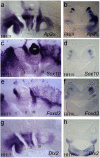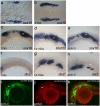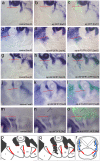The emergence of ectomesenchyme
- PMID: 18224711
- PMCID: PMC2266076
- DOI: 10.1002/dvdy.21439
The emergence of ectomesenchyme
Abstract
In the head, neural crest cells generate ectomesenchymal derivatives: cartilage, bone, and connective tissue. Indeed, these cells generate much of the cranial skeleton. There have, however, been few studies of how this lineage is established. Here, we show that neural crest cells stop expressing early neural crest markers upon entering the pharyngeal arches and switch to become ectomesenchymal. By contrast, those neural crest cells that do not enter the arches persist in their expression of early neural crest markers. We further show that fibroblast growth factor (FGF) signaling is involved in directing neural crest cells to become ectomesenchymal. If neural crest cells are rendered insensitive to FGFs, they persist in their expression of early neural crest markers, even after entering the pharyngeal arches. However, our results further suggest that, although FGF signaling is required for the realization of the ectomesenchymal lineages, other cues from the pharyngeal epithelia are also likely to be involved.
(c) 2008 Wiley-Liss, Inc.
Figures






References
-
- Abzhanov A, Tzahor E, Lassar AB, Tabin CJ. Dissimilar regulation of cell differentiation in mesencephalic (cranial) and sacral (trunk) neural crest cells in vitro. Development. 2003;130:4567–4579. - PubMed
-
- Baker CV, Bronner-Fraser M, Le Douarin NM, Teillet MA. Early- and late-migrating cranial neural crest cell populations have equivalent developmental potential in vivo. Development. 1997;124:3077–3087. - PubMed
-
- Carney TJ, Dutton KA, Greenhill E, Delfino-Machin M, Dufourcq P, Blader P, Kelsh RN. A direct role for Sox10 in specification of neural crest-derived sensory neurons. Development. 2006 - PubMed
-
- Chambers D, Mason I. Expression of sprouty2 during early development of the chick embryo is coincident with known sites of FGF signalling. Mech Dev. 2000;91:361–364. - PubMed
Publication types
MeSH terms
Substances
Grants and funding
LinkOut - more resources
Full Text Sources

